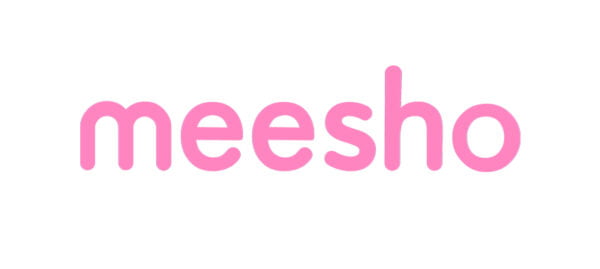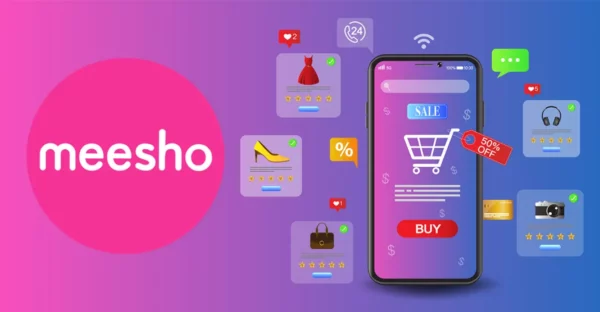Meesho – The Success Story of India’s No.1 Reselling App

Meesho – The Success Story of India’s No.1 Reselling App
One can easily start their own online business today while sitting comfortably in their homes and without spending much money. Over the past ten years, online shopping has advanced tremendously, and eCommerce businesses now make monthly sales in the billions of dollars all over the world.
Since the pandemic’s breakout, people have relied more than ever on internet shopping services, and many are taking advantage of this trend to build their own online businesses. That is also true of the online reselling market.
The cost of starting an internet resale service is quite low. Since you serve as a conduit between the supplier and the buyer, the costs associated with creating a product, managing inventory, and paying for all the necessary staff, tools, and equipment may be easily avoided in this way.
Meesho is a platform you might consider if you’re also considering creating your own resale business. It is an online resale platform that allows anyone to start a business without depositing any money upfront. Meesho takes great delight in reselling and is the market leader in India.

About Meesho
Meesho, an online reseller platform, probably doesn’t need an introduction. Due to its ease of use and low prices, the platform has carved out a market for itself and grown in popularity among both consumers and sellers. Meesho offers quick, safe transactions as well as affordable shipping and returns. More than 2.6 million resellers trust Meesho in India.
The Bangalore-based firm hopes to create a setting where anyone may start a business without needing to make a financial commitment. The company boasts of having more than 20,000 Meesho suppliers from more than 500 localities and over 2 million resellers. Meesho works on a 10-15% commission, and sellers may earn money with the app by introducing a gross margin to every transaction.
Meesho, the biggest resale platform in India, was established in 2015. The Meesho app primarily connects manufacturers and resellers. Manufacturers list their items on the Meesho shopping app, which enables retailers to select any of them and sell them to clients using social media platforms like Facebook, Instagram, and WhatsApp. Manufacturers of clothing, accessories, furniture, kitchenware, and cosmetics are some of the vendors who list their goods on Meesho.
Then, independent resellers can pick any item from these suppliers and market it to buyers on the aforementioned social media platforms. Selling an item can be as easy as uploading a picture of it on Instagram or creating a Facebook post about it. The Meesho items are delivered to the buyer’s home after the consumer and the reseller agree on the purchase. For a safe and efficient transaction, buyers can pay with a debit/credit card or cash on delivery.

Founders and Team
The company was founded by Sanjeev Barnwal and Vidit Aatrey in 2015.
Startup Story
Meesho was first launched in 2015 under the name FASHNEAR. Similar to Swiggy or Zomato, FASHNEAR operated on the same principle. Customers could purchase clothing and fashion accessories from local stores through FASHNEAR, which dealt with fashion-related commodities. Customers could order from these local stores using the FASHNEAR app, and delivery people were available to deliver the goods. Local businesses that offer clothing and accessories could register with the app.
However, the FASHNEAR business model’s weaknesses soon became apparent to the inventors. They noted that shoppers weren’t particularly concerned about purchasing clothing from nearby stores as one of the primary negatives. In addition, rather than selling their goods locally, the shop owners hoped to boost sales by selling their goods across the nation online. These issues motivated Vidit and Sanjeev to develop a more effective company strategy. The name Fashnear was changed to “Meesho” at the end of 2015.
To learn about the issues facing retailers and resellers, the founders made numerous visits. They observed that a large number of business owners were already selling things through WhatsApp, but their market reach was constrained because they only delivered locally. Additionally, they learned that majority of the MEESHO-registered businesses were run by women, who mostly marketed their products online rather than in actual stores. Because Meesho’s current business model has been developed with these realities and problems in mind, women may now start a reselling business from home without buying any inventory.
Additionally, the app now enables small retailers and producers to ship their products across the nation while taking care of product delivery, facilitating COD choices, and guaranteeing that customers can easily return the items if they want. As a result, Meesho acts as a link between suppliers (product makers and store owners who advertise their goods on Meesho), resellers, and customers. Meesho also helps suppliers manage their inventories.
Business Model and Revenue Model
We cannot state that Meesho uses a D2C (Direct to Consumer) business model regarding its business structure. The manufacturer sells a product directly to customers under the D2C business model. But Meesho uses resellers as a go-between for producers and customers. Meesho is a platform that assists companies (such as manufacturers and owners of reselling enterprises) in increasing their sales in exchange for various fees and incentives. As a result, Meesho has a B2B business model today. The company initially concentrated on the reseller business model but changed its direction in 2021.
Following are Meesho’s major sources of revenue–
-
Commission
Meesho’s primary source of income has been the commissions they charge the retailers. The product seller will be charged a set proportion of commission when a reseller sells a product on the Meesho platform. The commission-based industry is comparable to that of e-commerce websites like Flipkart, Amazon, and others. According to the corporate website, suppliers are not required to pay a commission on a few different product categories. There is no commission taken from the resellers.
Other than the commission, the other sources of revenue are –
-
Logistics
Meesho charges a fee for the logistics services it provides to suppliers. Its team is now striving to lower logistics costs to boost seller profitability.
-
Advertisements
Meesho receives some of its income from advertisements. As there are more vendors on the platform, merchants who wish to advertise their products in front of the network’s resellers and buyers must pay a fee for product promotion.
-
Data
Data is the new oil, as we all know, and data will undoubtedly provide cash for Meesho. The company did not violate any privacy rules, and they are only permitted to sell information that does not violate anyone’s privacy.
-
Funding and Investors
Meesho has amassed $1.1 billion in funding over the course of 11 rounds. On October 20, 2021, it received its most recent funding through a debt financing round.
According to people familiar with the company and the situation, Meesho anticipates an IPO in the early 2023 timeframe. It evaluates the Indian and US markets for its public listing and expects to be ready for listing by the end of 2022.

Growth and Revenues
Meesho reported a 750 per cent increase in users over the prior year, 2020, at its main seasonal sale event, the Maha Indian Shopping League, which took place from October 6 through October 9. About 60% of the entire demand came from Tier-4+ markets, which included remote areas like Khawzawl in Mizoram and Sopore in Jammu and Kashmir.
The business claims that because of its industry-first 0% fee arrangement, which was introduced earlier this year, merchants on Meesho saved over Rs 13.6 crore during the Christmas sale event alone. The company had a 314 per cent increase in merchant involvement during the Maha Indian Shopping League, which led to a 10X increase in revenues over the prior year. Before the sale event, Meesho onboarded over 100,000 suppliers with many novel efforts, such as free ad credits and free return shipping for the first 30 transactions.
Customers on the app received about Rs 60 crore discounts during the sale period. The company was very successful in its fashion division. Orders for men’s garments climbed by 640 per cent over the prior year, while orders for women’s clothing and accessories increased by 623 per cent.
In April 2021, Meesho, which had been valued at $2.1 billion following receipt of $300 million in a fresh funding round led by SoftBank Vision Fund 2, became the most recent firm to join the exclusive unicorn club.

Farmiso or Meesho Superstore
To rebrand, Meesho reopened Farmiso as Meesho Superstore on April 5, 2022. This was done to concentrate on the consumer expectations of basic needs in Tier 2 markets and above. Additionally, the well-known reselling app in India has revealed plans to include its groceries division into the primary Meesho platform. This is anticipated to happen in the first week of May 2022. The business takes great pride in successfully expanding its grocery service to 6 states in just 9 months. By the end of 2022, the business intends to open Superstore locations in 12 states.
In accordance with the drive for super applications, which will eventually rule the Indian and global digital ecosystems, the Meesho grocery app Farmiso’s rebranding and integration into the main Meesho app are highly significant. Furthermore, it is crucial to understand that the company has a huge market it can tap into despite only 0.5 per cent of supermarket sales occurring digitally.
Revenue, Expenses, Profit/Loss
Meesho generated sales totalling INR 341.6 cr in the 2020 fiscal year, of which Rs 307 cr were operational revenues. The company spent INR 657 cr on expenses during the same fiscal year, resulting in losses for the company of INR 306.70 cr. Meesho, which saw operating revenues climb by 2.6X in FY21 after experiencing a 3.8X increase in FY20, has now experienced two years of growth in the social commerce sector. The company has generated non-operating revenues totalling Rs 48.5 crore, increasing its operating revenue to Rs 793 crore.
Meesho spent Rs 1,337.3 crore in FY21, an increase of around 104% from Rs 655.4 crore raised in FY20. Meesho had to spend Rs 1.69 to generate only one rupee of revenue in FY21, a 20.6 per cent increase over what it did in FY20. During FY20, the social commerce unicorn had to invest Rs 2.13.
Meesho Revenue Breakdown
The company’s total income for FY21 was Rs 838.6 crore, up from Rs 348.7 crore in FY20. This is a 140 per cent increase.
Advertisements and Campaigns
On September 25, 2020, Meesho debuted its first television ad. The advertisement demonstrates how a woman may go by many titles, including wife, mother, daughter, sister, or daughter-in-law. Yet, despite all of her domestic duties, a woman may create her own identity and source of income with Meesho!
To target tier 2 markets and beyond, Meesho declared the beginning of its “Sahi Sahi Lagaya Hai” campaign in September 2021. Through this campaign, the company emphasises how its customers benefit from a large selection of goods in many categories from vendors all across the nation at reasonable costs, thanks to the Meesho app.
In February 2022, Meesho released a new campaign to address the question, “Loon ya na loon?” With this effort, Meesho continues its Sahi Sahi Lagaya campaign’s goal of assisting shoppers in resolving their dilemmas and maximising their expenditure.
Competitors
- Volusion
- Elenas
- DealShare
- GlowRoad
- Shop101
- CityMall
- Bulbul.tv
- SimSim
- Magento
- ALIPPO
- Huboo
- Drop

Challenges Faced
- Initial Startup Challenges
Online commerce started gaining popularity when Meesho was founded, but there were challenges such as a lack of supply, shipping issues, other options for transactions, etc.
The CEO claims that they have never kept any items in their own warehouses because they have always helped small businesses flourish. The COVID-19-induced lockdown made it difficult to obtain supplies, nevertheless. Things remained difficult even after the government provided a minor easement on car movement.
- The Pandemic-induced Challenges
For many of the vendors that sold their goods through Meesho, most of their income came from them. Covid affected the majority of their revenue. As a result, their only focus for the first few weeks was creating a foundational logistical network. Because each state has its own set of regulations regarding the entry and exit of vehicles, this was a challenging undertaking.
Most of the company’s female entrepreneurs’ (re-sellers) income came from the fashion industry, but these goods took some time to ship because they weren’t considered necessities. Therefore, their initial goal was to help these resellers make up some of the lost revenue. They started promoting essential supplies—a product category they had never supplied before—to their dealers at that point. The items offered were masks, personal care products, sanitisers, and groceries. They also devised a plan to have their resellers make masks at home and sell them.
Many of their vendors choose to sew the masks themselves, buying their inventory from them and selling it independently on the market. Thousands of business owners participated in the campaign thanks to the organisation, and members of their logistics team even went home and bought some handmade masks.
However, not everyone was able to participate in this improvisation technique. Therefore, they developed a micro-credit strategy to ensure that their resellers could make some money. As part of this campaign, they offered their resellers low-interest loans of Rs 5,000. They had access to all of its resellers’ bank accounts and earnings data, so they could provide these loans without performing any formal vetting or paperwork. They can say that “these moves reinforced our relationship and trust with our user base” even in these uncertain times.
- Change in Strategy, Huge Cash Burn and No Profit
Meesho had once been the face of social commerce with its $4.9 bn valuations that it announced. Still, with a change in strategy, high cash burn, no profit in sight, and escalating competition from major players like Flipkart and Amazon, the company now appears to be going through hard times and is unable to speak in front of investors. Recently, the company modified its business strategy to resemble eCommerce platforms more closely.
Meesho abruptly switched its focus from social commerce to business-to-consumer (B2C), shelved plans for international expansion to support small-town markets, and went from a zero-commission model to ad-monetisation. According to an undisclosed investor, the company has reportedly already spent more than $500 million over the past two years but is currently starting over. It used to have to contend with smaller players like Shop101 and Glowroad, but now the competition has tripled. Larger e-commerce firms like Flipkart and Amazon are now giving Meesho fierce competition.
In July 2021, Flipkart joined the social commerce space with its Shopsy app, and by stealing some of Meesho’s resellers, it challenged Meesho. In addition, the well-known eCommerce platform from Southeast Asia, Shopee, was introduced in India in 2021, which is also hurting its business.
Shopee has already amassed a $150 billion market share in over 13 nations in Asia, South America, and Europe.
Meesho Layoffs
As of April 11, 2022, Meesho laid off approximately 150 employees due to a reorganisation exercise for the Meesho Superstore grocery delivery service. The eCommerce unicorn is looking forward to streamlining and improving its grocery business. Eliminating redundancies within the core Meesho business and its operations have led to the layoff of a small number of full-time employees and reevaluating of some third-party contractual responsibilities.
Future Plans
Meesho plans to surpass its June 2022 monthly transactional user count of 100 million by December 2022. It intends to treble its technical and product talents, increase the number of products it offers to over 50 million, and establish itself as India’s top marketplace for buyers, sellers, and entrepreneurs with the help of the financing it got in the most recent funding round.
Meesho’s community group purchasing (CGB) business, Farmiso (Grocerie business), is attempting to expand its grocery and fast-moving consumer goods services to over 200 communities. The firm is making online grocery shopping affordable for first-time customers in India’s Tier II marketplaces, allowing them to choose from a wide variety of commodities at ticket sizes as low as $1–$2.
According to the news from June 13, 2022, Vidit Aatrey announced Meesho’s intentions to list on the bourses over the following 12 to 24 months. The company’s CEO wasn’t exactly sure whether the company would be listed on the US or Indian stock exchanges. Aatrey also acknowledged that the startup would aim to turn a profit at that point.
edited and proofread by nikita sharma




